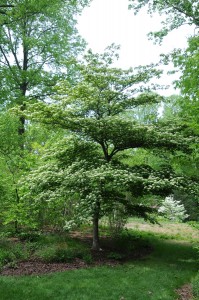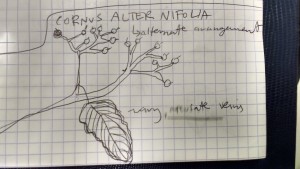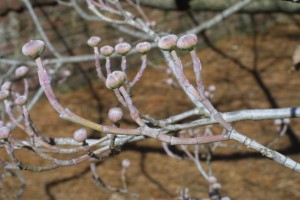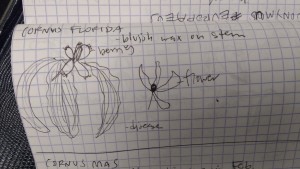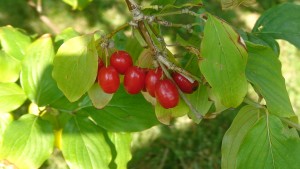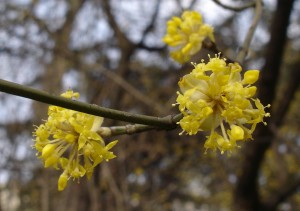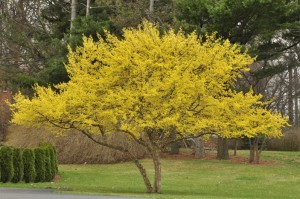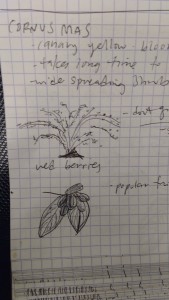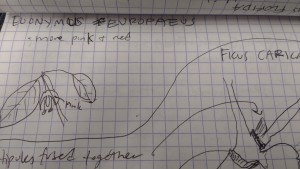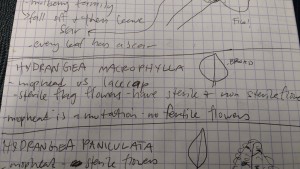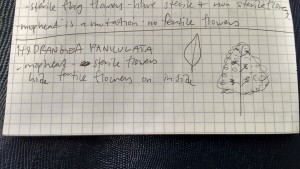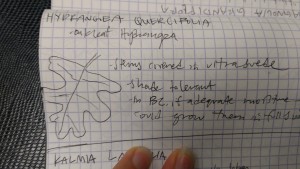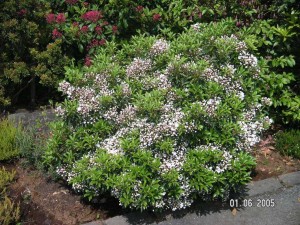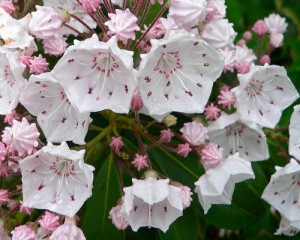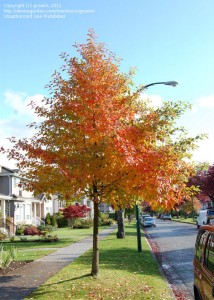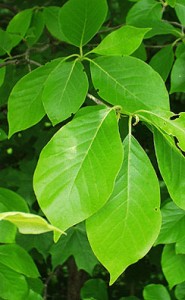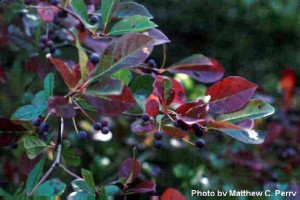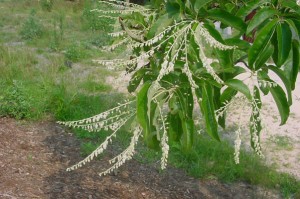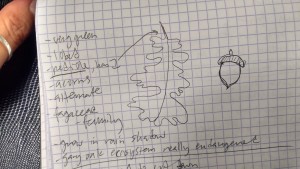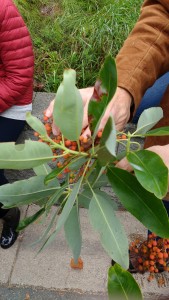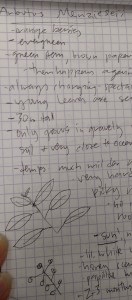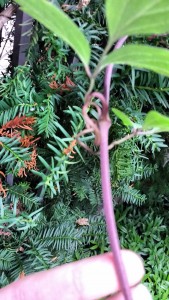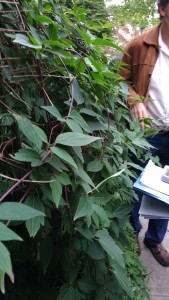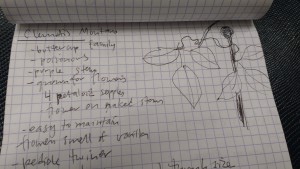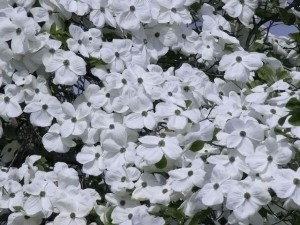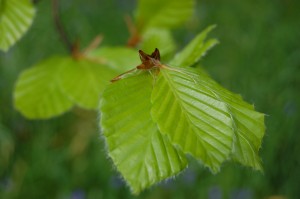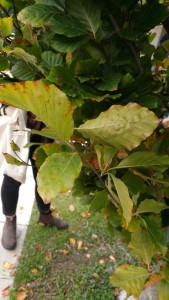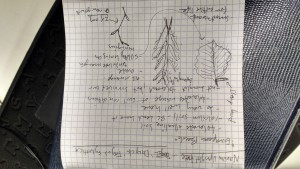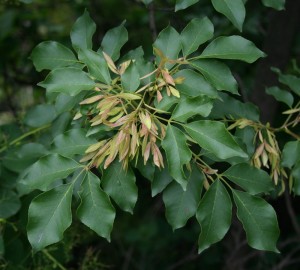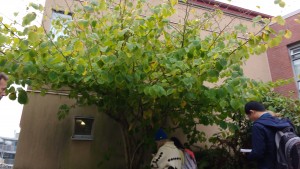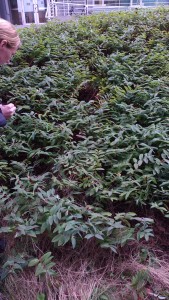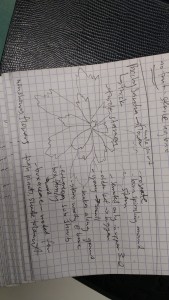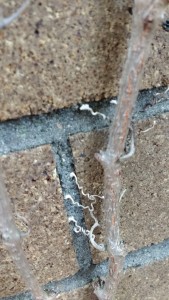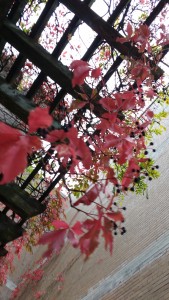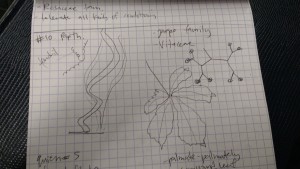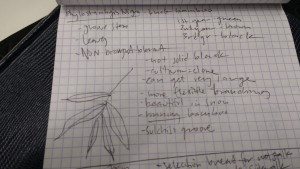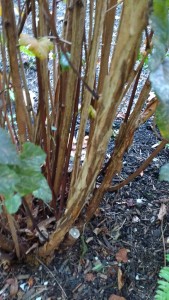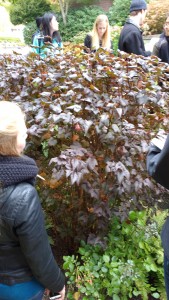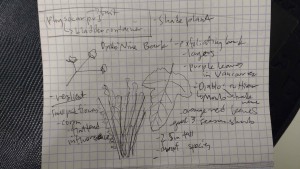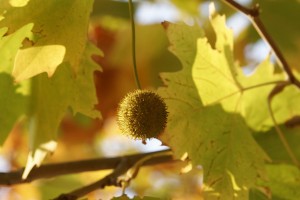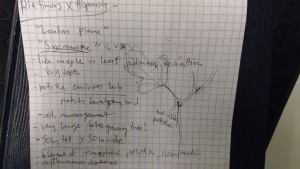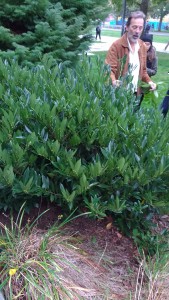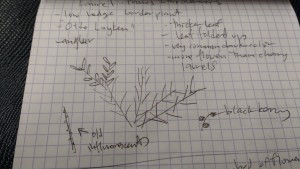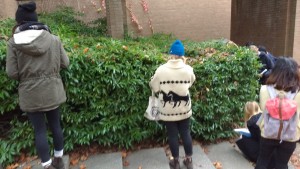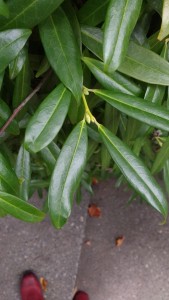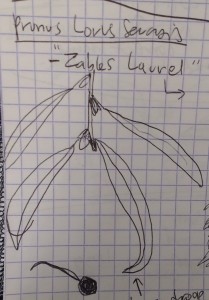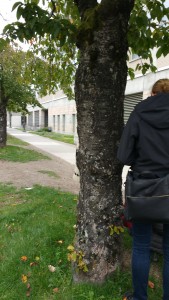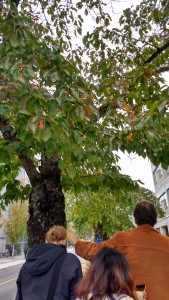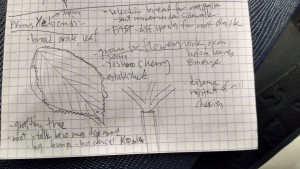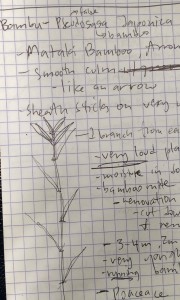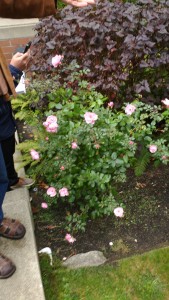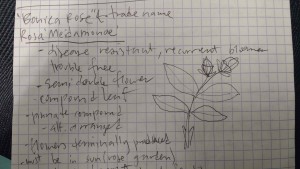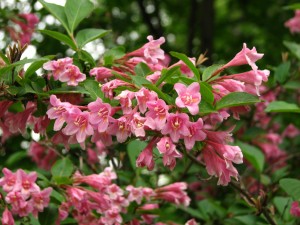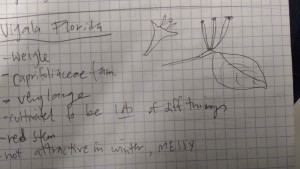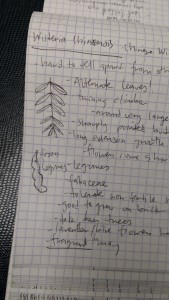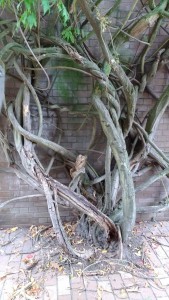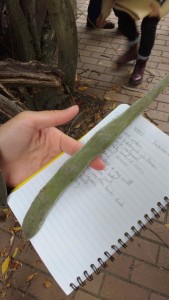ACER PENSYLVANICUM
o Snake Bark Maple
oSapindaceae o Zone 3-7 o15’x20′ o shrubby understory maple
o medium
o well-drained soils in part shade. rounded but uneven crown that is sometimes flat-topped. o Obovate, double-serrulate, three-lobed leaves (to 7” long)
o pink hues in spring, mature to dark green by summer and turn bright yellow in fall. Leaf purportedly resembles a goose foot, hence the common name of goosefoot maple
o Small yellow flowers (1/3” diameter) bloom in pendant racemes (to 6” long) in spring (May). Flowers give way to winged samaras (to 1” long). Moose and white tailed deer often browse the leaves and young twigs hence the common name of moosewood
o Key ornamental features are its interesting bark and fall color. Greenish bark on young branches and young trunks is vertically marked with distinctive white stripes (hence the common names of snakebark maple and striped maple). Stripes may vanish over time as older bark turns reddish brown
ACTINIDIA ARGUTA
Grape Kiwi
Acitinidiaceae
Zone 3-8
20′ x 5′
Climbing vine
Medium water
average, medium moisture, well-drained soils in full sun to part shade
Glabrous
Simple leaf, alternate, large broad ovate leaf
This vine can be grown both for its beautiful foliage and its edible fruit. Can be grown in containers.
scented greenish-white flowers (to 3/4″ long) bloom in June and edible grape-sized smooth-skinned fruits (to 1 1/4″ long) mature in September-October.
ACTINIDIA DELICIOSA
- Kiwi
- Actinidiaceae
- zone 6
- 30′ tall, spreads vigorously, can climb very high in trees
- Vigorous deciduous twining vine
- Moist soil, sun to part shade
- Large dark green and hairless leaves, when young they are downy and white. Alternate, long petioles with red fuzzy stalks
- Blooms in May-June with large fuzzy kiwi fruit
- a lot of maintenance, frequent pruning with strong support to twine on. Smells like rotten milk for about 4 m from plant
- put on heavy trellis, need to plant both male and female plants to produce fruit
CAMPSIS X TAGLIABUANA ‘MME. GALEN’
- Trumpet Creeper
- Bignoniaceae
- ‘Mme. Galen’ Discovered by Taglia brothers in Italy
- Zone 6
- Big scale, suckering vine. 30′ tall.
- Grows up to top of support then becomes shrubby.
- moist, well drained soil, full sun, loves heat
- pinnate leaf, compound, coarsely toothed, opposite
- Yellow fall color, not flashy
- Broad, open throated flower. orange or red flowers, trumpet shaped. Butterflies and hummingbirds love them.
- Vigorous vine, needs careful maintenance
- sheltered site
- Toothed leaf, unlike Wisteria . Suckering aerial root.
CORNUS ALTERNIFOLIA
- Pagoda Dogwood
- ‘Argentea’ variegated white leaves
- Cornaceae
- zone 3
- 15-25′ tall
- Horizontally spreading branches , low branching
- medium water
- acidic organic soil. sun to part shade
- alternate leaf arrangement, crowded around end of twig, arcuate (all cornus) veined leafs with undulating margins, elliptical leaves
- red fall color
- Yellow-white flowers born in flat-topped clusters, attract butterflies, fruit is bluish-black
- not tolerant of road salt/ pollution
- good for residential/park planting, good fall color, ornamental
CORNUS FLORIDA
- Eastern Flowering Dogwood
- Cornaceae
- zone 5
- 30′ tall x 30′ wide
- Deciduous tree
- Medium water
- rich, moist, acidic soil in full sun to part shade
- oppositely arranged, simple, parrallel arcuate veins, glabrous. end of stems are white and grow UP, leaves hang down
- fall color orange, red
- flowers are little buttons with white brachts that look like butterflys,blue lozenge shaped fruit
- Vancouver is too wet for this tree, disease prone here
CORNUS MAS
- Cornelian Dogwood
- Cornaceae
- zone 4
- 6m tall x 5m spread
- Deciduous SHRUB
- messy looking
- Medium water
- well drained soil, sun to part shade
- oppositely arranged, with prominent pinnate arcuate veins, ovate shape
- reddish purple
- canary yellow flowers in small clusters, not as showy as other dogwoods
- beautiful lozenge red fruit, edible, high in vit. c, commonly used in Persian cooking
- hard to find in nursery, big roots, messy branching, resistant to dogwood prone diseases, adaptable, long living
- good at back of border, specimen tree, attracts birds
EUONYMUS EUROPAEUS
- European Euonymous, Dingle Dangle Tree 🙂
- Celastraceae
- zone 4
- 10m tall x 7 m spread
- oval, vertical, round deciduous tree, flat top, spreading,
- low to medium water
- well drained, acidic ferticle soil, full sun to part shade
- elliptical leaves with fine sinuous margins, pinnate veins, simple, opposite arrangement
- beautiful fall color(purple/yellow)
- pink fruit capsules, orange dangly seeds
- poisonous for humans
- pest free here, very tough plant!
- Nice small shade tree, screening, windbreak, woodland margin
- pinker leaves and seed cover planipes
FICUS CARICA
- Fig Tree
- Moraceae
- zone 6
- 2-3m tall x 3-4m spread
- deciduous tree or large shrub
- low water use, water in summer
- well drained soil, full sun for fruit
- alternate leaf, distinct thick lobed leaf, has stipule!- when they fall off, leaves grow from scar.
- no fall color
- flowers are inside fruit. !! fruit crop early summer and has another crop later in sumer
- milky sap is an irritant
HYDRANGEA MACROPHYLLA
- Big Leaf Maple
- Hydrangeaceae
- zone 6
- 2m high x 2 m spread
- rounded deciduous shrub
- lots of water! water pigggg
- rich moist soil, part shade. Basic soil= pink flowers, acidic soil= blue flowers, white flowers aren’t affected by pH levels
- simple leaf, toothed, ovate with prominent veins on back, oppositely arranged, more ovate than paciulata
- leaves and flowers dry up in winter, brownish blechh
- flowers produced on previous year’s growth, don’t cut it back!
- inflorescence– mophead= sterile flowers, lace cap= both sterile and fertile flowers
- drought tolerant, mass plantings are beautiful
HYDRANGEA PANICULATA
- Pee Gee Hydrangea
- Hydrangeaceae
- zone 4
- 16′ high and wide
- rounded deciduous shrub
- moderate water, most are drought tolerant
- well drained soil, part sun to shade
- whorls of 3 leaves, ovate shape , opposite, simple, toothed
- brown in fall/ winter
- sterile and fertile flowers, lace cap panicle, flowers on current seasons growth, pink beautiful flowers that come out as white in May-June, Changes color! Coool.
- some think too big for residential.
- cone shaped flower panicle
HYDRANGEA QEURCIFOLIA
- Oak Leaf Maple
- Hydrangeaceae
- zone 5
- 8′ tall x 6′ wide
- arching deciduous shrub
- moist, well drained soil, can grow in full sun with moisture, shade tolerant in Vancouver
- opposite, attractive coarse oak-like leaf shape
- stems covered in brown tomentum, coarse leathery leaves
- Purple bronze leaf fall color
- blooms late in june-sept., lacecap panicle, conical inflorescence
- pest free
- Mountain Laurel
- Ericaceae
- zone 4
- 12′ tall x 8′ wide
- evergreen shrub, looks like rhodo
- medium water
- acidic, humousy soil, sun to part shade. put mulch around it, dont plant deeply.
- simple leaf, congested at tip, alt. arrangement, gloss on leaf is distinct, broad leaf for Kalmia.
- beautiful flowers, white/pink with pink/[urple markings. stames are stuck in pockets until agitated by pollinator, stems flick out and hit bee, etc.
- drought tolerant, likes woody mountain, slow growing
MAGNOLIA GRANDIFLORA
- Souhern Magnolia
- Magnoliaceae
- ‘Southern Charm’ aka Teddy Bear
- zone 6
- 80′ tall x 50′ wide
- big broadleaf evergreen, dense canopy
- moderate water
- warm well drained soil, no compact soil, protected from strong wind
- spirally arranged, brown fuzzy back
- giant white flowers, smell like perfume, very large seed head
- brittle roots and limbs, cant garden under
NYSSA SYLVATICA
- Black Tupelo
- Nyssaceae
- zone 5
- 22m tall x 10m wide
- oval, vertical, spiky pyramidal form, twiggy
- deciduous tree
- medium to wet
- acidic deep soil, sun to part shade
- oblanceolate leaf, alternate, glossy
- scarlet fall color
- insig. flowers, bees love them!
- berries – red petioles where berries are attached
- tap rooted trees, need to be pruned roots while at nursery, tough and cold hardy.
- great tree!
OXYDENDRUM ARBOREUM
- Sorrel tree
- Ericaceae
- zone 5
- 15m tall x 10m wide
- deciduous tree, shrubby when young then forms broad pyramidal crown
- medium water
- acidic rich, moist, well-drained soil, full sun to part shade
- toothed leaves, alternately arranged, simple
- spectacular rich orange-red fall color
- showy flowers bloom in late summer, “tupelo honey’ made from bees who use the nectar), white fruit in fall
- after fall it gets sad and wispy, grows slow, wood is a laxative
- attracting good insects
QUERCUS GARRYANA (N)
- Gary Oak
- Fagaceae
- zone 7
- 30m tall x 15m wide
- Large upright deciduous tree
- shrubby for years before full tree
- low water, summer dry
- rocky soil
- alter., irregularly pinnately lobed, shiny leaves
- green-yellow fall color
- non-showy flowers, catkin, monecious, acorns–taken by squirrels
- slow growing! one of the most endangered ecosystems.
- symbol of strength–plant one!
RHUS TYPHINA
- Staghorn Sumac
- anacardiaceae
- zone 3
- 7m tall and wide
- deciduous shrub/tree(specimen or colony), fuzzy stems like antlers!
- low water
- rocky , well drained
- alternately arranged, compound with pinnate venation, green above
- very bright red, orange and yellow! pretty!
- flowers in panicles–very showy. can be used to make lemonade. bobs!
- can spread vigorously, runs like bamboo
- attracts birds and beez, erosion control, screening
ROSA RUBRIFOLIA
- Rosa Glauca( means blue-grey in latin)
- Rosaceae
- zone 2-8
- 8′ tall x 7′ wide
- dense deciduous shrub, gets big, hardy, not very thorny
- medium water
- well drained, loves sun
- alt. ,purply leaves, pinnately compoudn 5-7 leaflets, ovate, glaucous, new growth is red
- blooms may-june, pink rose flower, atypical rose, pretty winter fruit- showy red- attracts birds and butterflies
- susceptible to rose diseases in this climate
- resistant to blackspot and powdery mildew
- can be hedge, very hardy
SPIRAEA JAPONICA
- Japanese Spiraea
- Rosaceae
- ‘Gold Mound’-yellow leaves
- zone 4
- 2m tall x 1.5 wide
- moundy, hardy deciduous shrub
- medium water
- well drained soil but very adaptable, loves sun
- alt, have throns and stipules, simple toothed leaves
- brown-purple fall color
- flat topped inflorescence, little pink flowers May-July, very showy, attractive to butterflies, persistent brown capsules













